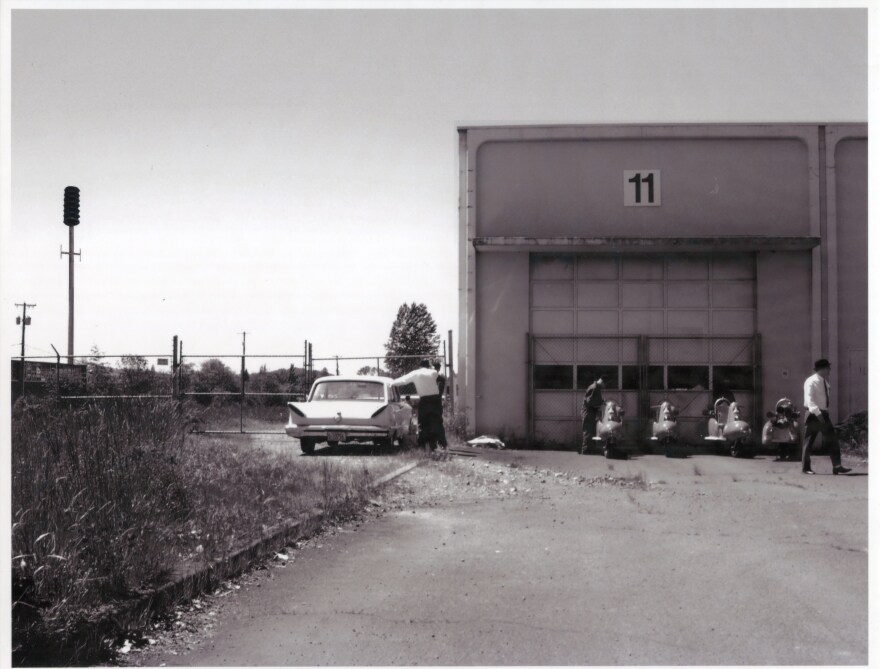Randy Regier creates fiction with his art. Not in the sense that a painting of a scene that never took place is fiction, but in the way a teenage boy might get a kick out of placing an odd object in his house to make his mom pause.
When pressed about the mysterious item, that teenager might say, “But, Mom, the garden gnome has always been next to the coffee mugs. Don’t you remember?”
In Regier’s case, the Kansas City-based artist has created a civil defense escape scooter for display during Kansas City’s two-month Open Spaces arts festival. But he doesn’t mean to play a joke on anyone or, as he puts it, “make too light of a really dark chapter that’s not yet closed.”
On a recent windy morning on the sidewalk in front of River Market Antiques, where the scooter is displayed in a front window, Regier explains, “I have a bit of a reputation for playing fast and loose with history, but my intentions are more about exploration than they are about deceit. I never intend to deceive.”
From the early 1940s through the late 1970s, the United States government had various iterations of departments to educate and warn citizens about the threat of attack from hostile nations.
During the Cold War, citizens were encouraged to, among other things, build fallout shelters near their homes for protection during a nuclear attack. This is where Regier’s scooter comes in.

What if, in addition to canned water and protective suits, some people had super-fast scooters?
In among the antique store’s various real-life artifacts (he calls them “true”), the shiny yellow scooter with the civil defense logo looks perfectly natural.
Not much else in the shop window is Regier’s creation. The 1957 civil defense emergency triage case filled with leg and arm braces is authentic, as is the odd helmet with “Captain Crest” stenciled over the bill. And it’s only on close inspection that the scooter might begin to deconstruct before a viewer’s eyes.
Are those 1950 Plymouth car fenders on the back? Yes. Is that a piece of a rototiller? Yes. And isn’t that a plastic champagne flute with a doorstop spring on front? You are correct.
Regier’s skills as an auto mechanic add to the authenticity of the creation. The paint job is nothing an amateur could have achieved, and the bike really runs — though he says it would be a bad idea for anyone to ride it; the engine is made from the plans for a Nazi V-1 flying bomb (or buzz bomb), the only bomb ever powered by a pulse jet. You could say the engine runs hot.

“Dreams of Flight,” as Regier’s project is called, is spread over three locations. Besides the window at River Market Antiques, which houses the scooter and other objects, the Kansas City Art Institute’s Crossroads Gallery has an entire wall dedicated to the scooter’s backstory.
And at the National Museum of Toys and Miniatures, visitors will find a carefully manufactured toy replica of the scooter, accompanied by what Regier describes as, “a model kit of (the scooter) that perpetuates the notion that at one time it was popular enough that kids had a small version they could build and play with. It keeps weaving that fiction into our collective memories even though none of us recalls this thing.”
At bottom, the seed for the whole project is a quotation Regier found from the 14th century mystic theologian, Julian of Norwich: “There is only one suffering and we are all part of it.”
And, he adds, “If the Cold War isn’t about this silent, abiding, abject terror, I don’t know what it’s about.”
Regier considers Julian of Norwich’s statement in the context of nuclear attack: If a bomb levels Kansas City, we’ll all be one in our suffering. He says he worries that it wouldn’t take sheltered people long to divide themselves again, though.

Why do we insist on separating ourselves? He thinks the material things we surround ourselves with may aid in a deeper understand of our own behavior.
Regier says we can learn a lot about ourselves and our culture from the objects we use every day, the objects we save and protect, and the objects we consider historically valuable.
Nothing in the display at River Market Antiques has particular monetary value, he notes.
“But everything is part of a larger cultural narrative about fear, aspirations, entertainment, politics, workaday (the lunch pail). Everything in here is about a narrative that a lot of people have been a part of and can connect with, and they each play a significant role in this window; there’s nothing in there by chance.”

When a false object — an object that does not belong — is added to the collection, or to our collective memory, every other object is viewed with fresh consideration, Regier’s pieces suggest.
And if we can consider our own history even a little bit objectively, we just might reconsider — or at least theoretically reject — what’s happening in the present.
“Dreams of Flight” guided trolley tours 11 a.m. October 6 and 13 beginning at the National Museum of Toys and Miniatures, 5235 Oak Street, Kansas City, Missouri 64112. Includes a stop for a reception at KCAI Crossroads Gallery, 1819 Grand, Kansas City, Missouri 64108. Free, but reservations required: Call 816.235.8005 or email mercierk@toyandminiaturemuseum.org to RSVP.
The Open Spaces exhibition “Dreams of Flight” is on display through October 28 at River Market Antiques, 115 West 5th Street, Kansas City, Missouri 64105; KCAI Crossroads Gallery, 1819 Grand, Kansas City, Missouri 64108; and the National Museum of Toys and Miniatures, 5235 Oak Street, Kansas City, Missouri 64112.
Follow KCUR contributor AnneKniggendorf on Twitter, @annekniggendorf.






